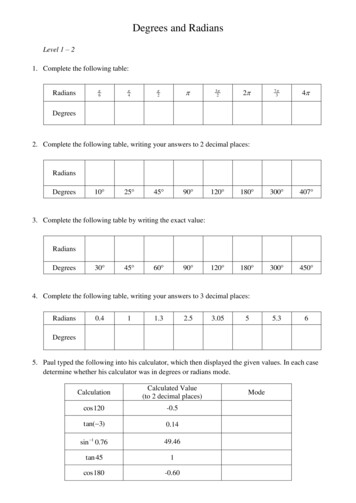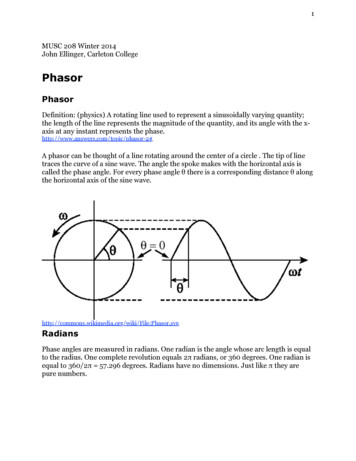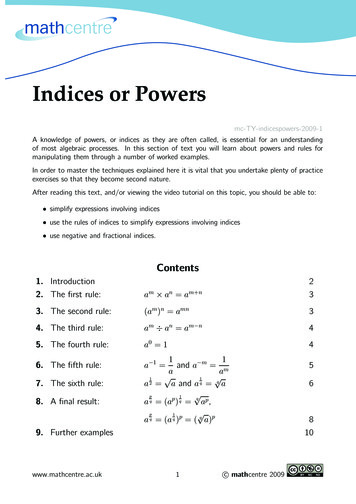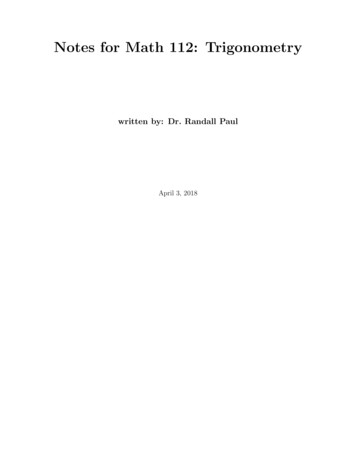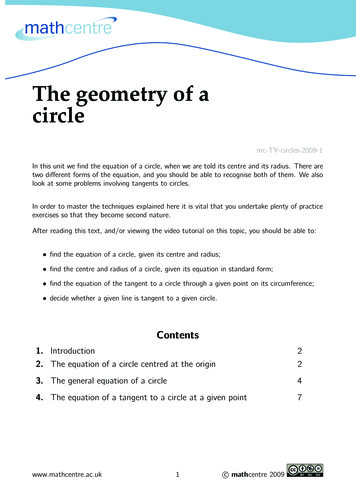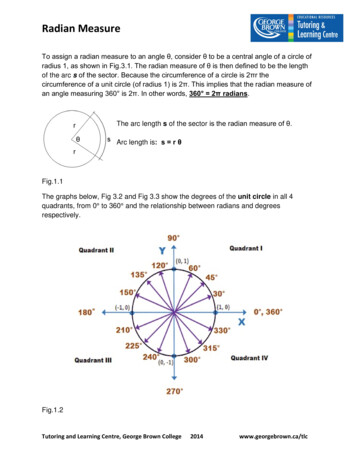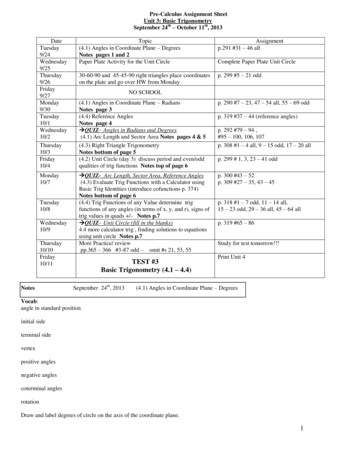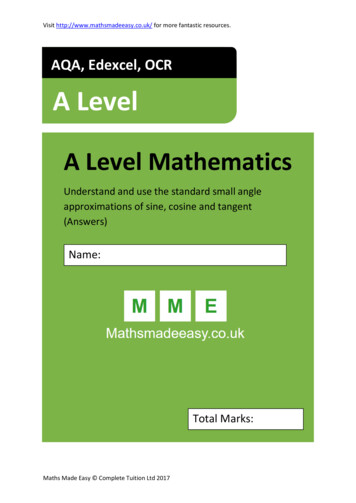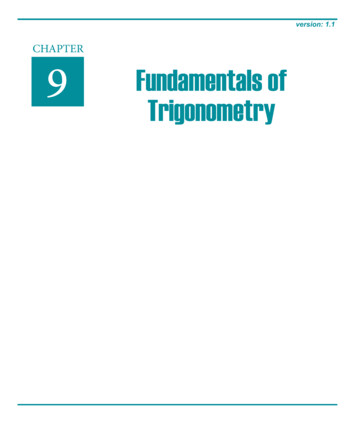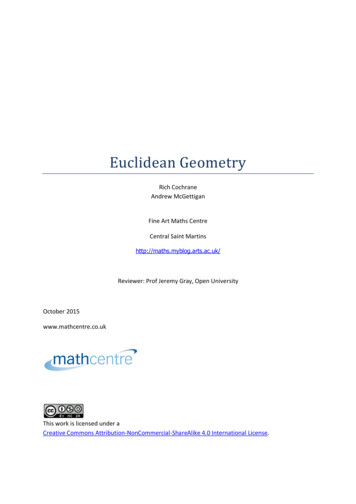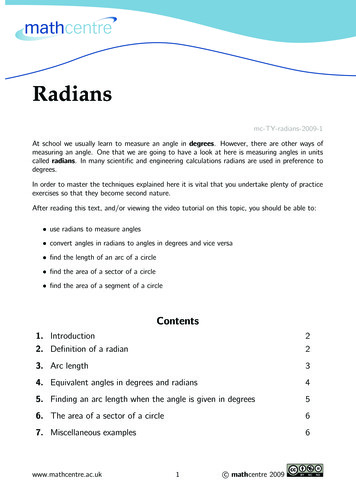
Transcription
Radiansmc-TY-radians-2009-1At school we usually learn to measure an angle in degrees. However, there are other ways ofmeasuring an angle. One that we are going to have a look at here is measuring angles in unitscalled radians. In many scientific and engineering calculations radians are used in preference todegrees.In order to master the techniques explained here it is vital that you undertake plenty of practiceexercises so that they become second nature.After reading this text, and/or viewing the video tutorial on this topic, you should be able to: use radians to measure angles convert angles in radians to angles in degrees and vice versa find the length of an arc of a circle find the area of a sector of a circle find the area of a segment of a circleContents1. Introduction22. Definition of a radian23. Arc length34. Equivalent angles in degrees and radians45. Finding an arc length when the angle is given in degrees56. The area of a sector of a circle67. Miscellaneous examples6www.mathcentre.ac.uk1c mathcentre 2009
1. IntroductionAt school we usually learn to measure an angle in degrees. We are well aware that a full rotationis 360 as shown in Figure 1.o360Figure 1. A full rotation is 360 .However, there are other ways of measuring an angle. One way that we are going to have a lookat here is measuring angles in units called radians. In many scientific and engineering calculationsradians are used in preference to degrees.2. Definition of a radianConsider a circle of radius r as shown in Figure 2.rr1 radrFigure 2. The arc shown has a length chosen to equal the radius; the angle is then 1 radian.In Figure 2 we have highlighted part of the circumference of the circle chosen to have the samelength as the radius. The angle at the centre, so formed, is 1 radian.Key PointAn angle of one radian is subtended by an arc havingthe same length as the radius as shown in Figure 2.www.mathcentre.ac.uk2c mathcentre 2009
3. Arc lengthWe will now use this definition to find a formula for the length of an arbitrary arc.We have seen that an angle of 1 radian is subtended by an arc of length r as illustrated in theleft-most diagram in Figure 3. By extension an angle of 2 radians will be subtended by an arc oflength 2r, as shown.2rrrr1111rrFigure 3. An angle of 2 radians is subtended by an arc of length 2r.Note from these diagrams that the length of the arc is always given bythe angle in radians the radiusIn the general case, the length s, of an arbitrary arc which subtends an angle θ is rθ as illustratedin Figure 4.srθrFigure 4. The arc length s, is given by r θThis gives us a way of calculating the arc length when we know the angle at the centre of thecircle and we know its radius.Key Pointarc length s rθ(note: θ must be measured in radians)Exercise 1Determine the angle (in radians) subtended at the centre of a circle of radius 3cm by each ofthe following arcs:a) arc of length 6 cmb) arc of length 3π cmc) arc of length 1.5 cm d) arc of length 6π cmwww.mathcentre.ac.uk3c mathcentre 2009
4. Equivalent angles in degrees and in radiansWe know that the arc length for a full circle is the same as its circumference, 2πr.We also know that the arc length rθ.So for a full circle2πr rθthat isθ 2πIn other words, when we are working in radians, the angle in a full circle is 2π radians, in otherwords360 2π radiansThis enables us to have a set of equivalences between degrees and radians.Key Point360 2π radiansfrom which it follows thatπradians2π60 radians3180 π radians90 πradians4π30 radians645 The Key Point gives a list of angles measured in degrees on the left and the equivalent list inradians on the right. It is important in mathematical work that you record correctly the unit ofmeasure you are using.Another useful relationship is given as follows:π radians 180 so1 radian 180degrees 57.296 π(3 d.p.)So 1 radian is just over 57 .Some notation.There are various conventions used to denote radians. Some books and some teachers use ‘rads’as in 2 rads. Others use a small c as in 2c . Some others use no symbol at all and assume thatradians are being used. When an angle is expressed as a multiple of π, for example as in the, it is taken as read that the angle is being measured in radians.expression sin 3π2www.mathcentre.ac.uk4c mathcentre 2009
Exercise 21. When each of the following angles is converted from degrees to radians the answer can beexpressed as a multiple of π (note that it may be a fractional multiple). In each case statethe multiple is 45 ).the multiple (e.g for an answer of 4π5oooa) 90b) 360 c) 60d) 45oe) 120o f) 15og) 135o h) 270o2. Convert each of the following angles from radians to degrees.a) π2 radiansb) 3πradians c) π radians d) π6 radians4e)5π radiansf)4π5radiansg)7π4radiansh)π10radians3. Convert each of the following angles from degrees to radians giving your answer to 2decimal places.a) 17o b) 49o c) 124o d) 200o4. Convert each of the following angles from radians to degrees, giving your answer to 1decimal place.a) 0.6 radians b) 2.1 radians c) 3.14 radians d) 1 radian5. Finding an arc length when the angle is given in degreesWe know that if θ is measured in radians, then the length of an arc is given by s rθ.Suppose θ is measured in degrees. We shall derive a new formula for the arc length.sroθrFigure 5. In this circle the angle θ is measured in degrees.Referring to Figure 5, the ratio of the arc length to the full circumference will be the same asthe ratio of the angle subtended by the arc, to the angle in a full circle; that issθ 2πr360 So, when θ is measured in degrees we can use the following formula for arc length:s 2πr θ 360 Notice how the earlier formula, used when the angle is measured in radians, is much simpler.www.mathcentre.ac.uk5c mathcentre 2009
6. The area of a sector of a circleA sector of a circle with angle θ is shown shaded in Figure 6.rθrFigure 6. The shaded area is a sector of the circle.The ratio of the area of the sector to the area of the full circle will be the same as the ratio ofthe angle θ to the angle in a full circle. The full circle has area πr 2 . Thereforearea of sectorθ area of full circle2πand soarea of sector θ πr 22π1 2r θ2Key Point1area of sector r 2 θ2when θ is measured in radians7. Miscellaneous ExamplesExampleConsider the circle shown in Figure 7. Suppose we wish to calculate the angle θ.2510θ10Figure 7. Calculate the angle θ.www.mathcentre.ac.uk6c mathcentre 2009
We know the arc length and radius. We can use the formula s rθ. Substituting the givenvalues25 10θand soθ 25 2.5 rads10What is this angle in degrees ? We knowπ rads 180 and so180 1 rad πIt follows that2.5 rads 2.5 180 143.2 πExampleRefer to Figure 8. Suppose we have a circle of radius 10cm and an arc of length 15cm. Supposewe want to find (a) the angle θ, (b) the area of the sector OAB, (c) the area of the minorsegment (shaded).B1510θO10AFigure 8. The shaded area is called the minor segment.15(a) Using s rθ we have 15 10θ and so θ 1.5c .101(b) Using the formula for the area of the sector, A r 2 θ, we find21 2r θ21 2 (10 )(1.5)2 75 cm2area (c) We already know that the area of the sector OAB is 75cm2 . If we can work out the area ofthe triangle AOB we can then determine the area of the minor segment. (Recall the formulaefor the area of triangle, A 21 ab sin C.)1 2r sin θ21 210 sin 1.5 2 49.87 cm2area of triangle www.mathcentre.ac.uk7c mathcentre 2009
Therefore the area of the minor segment is75 49.87 25.13 cm2(to 2 dp.)ExampleSuppose we have an angle of 120 . What is this angle in radians ? We know thatπ rads 180 and soπrads 1 180thenπ 120 rads180radians ( 2.094 radians).120 This can be written as2π3Exercise 3A sector of a circle is an area bounded by two radii and an arc. A sector has an angle at thecentre of the circle. All the questions below relate to a circle with radius 5cm.1. Determine the length of the arc (correct to 2 decimal places) when the angle at the centreis a) 1.2 radians b) π2 radians c) 45o2. Calculate the area (correct to 2 decimal places) of each of the three sectors in Question1.3. A sector of this circle has area 50 cm2 . What is the angle (in radians) at the centre of thissector?AnswersExercise 1a) 2 b) π c) 0.5d) 2πExercise 21g) 43 h) 321. a) 21 b) 2 c) 31 d) 14 e) 23 f) 122. a) 90o b) 135o c) 180o d) 30o e) 900o f) 144o g) 315o h) 18o3. a) 0.30 radians b) 0.86 radians c) 2.16 radians d) 3.49 radians4. a) 15.3o b) 120.3o c) 179.9o d) 57.3oExercise 31. a) 6 cm b) 7.85 cm c) 3.93 cm2. a) 15 cm2 b) 19.63 cm2 c) 9.82 cm23. 4 radianswww.mathcentre.ac.uk8c mathcentre 2009
4. Convert each of the following angles from radians to degrees, giving your answer to 1 decimal place. a) 0.6 radians b) 2.1 radians c) 3.14 radians d) 1 radian 5. Finding an arc length when the angle is given in degrees We know that if θ is measured in radians, then the length of an arc is given by s rθ. Suppose θ is measured in degrees.
